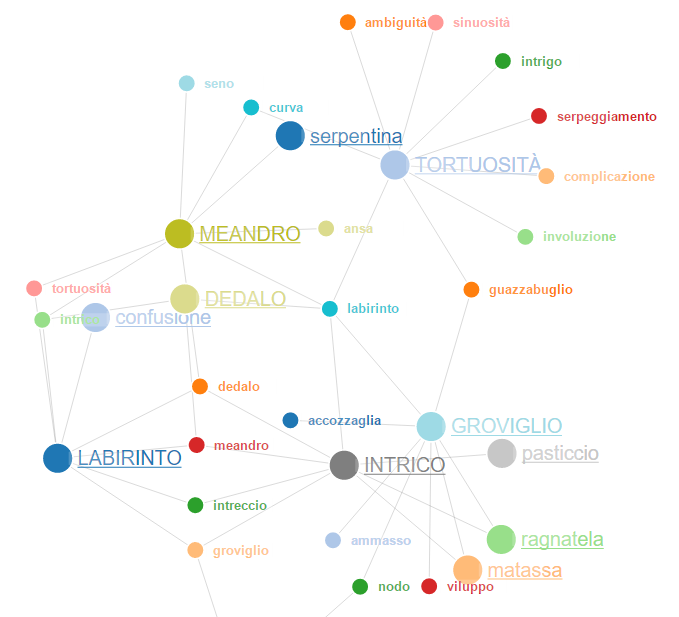VISUAL ICONCLASS - Tree Layout visualization | Indented Tree Visualization | Searchable Database (coming soon) | A Thousand Masterpieces described and commented (coming soon)
Wait few seconds while data loading
Read a short presentation of Iconclass system or just click first node below to expand content tree
(From Iconclass website) The unique elements of the Iconclass system are its alphanumeric classification codes, called notations. Notations always begin with one of the digits 0 - 9, corresponding with the ten main divisions of Iconclass.
Notations can be used to describe or index the subjects of visual documents regardless of the complexity of the subjects. Several notations can be used to describe complex subjects.
Every notation is part of a hierarchical structure and, as such, incorporates all of its iconographical broader terms. The text explaining the meaning of an Iconclass notation is the notation's 'textual correlate'.
Main divisions of the Iconclass classification system
The main divisions of the Iconclass system are represented by digits 0 to 9. Of these ten 'main divisions', the numbers 1 to 5 are 'general' topics, designed to comprise all the principal aspects of what can be represented. Divisions 6 through 9 accommodate 'special' topics, coherent subject matter of a narrative nature, with an emphasis on the Bible (7) and Classical Mythology (9). A tenth division, represented by the number 0, was added in 1996 at the request of Iconclass users, to accommodate abstract art.
0 Abstract, Non-representational Art
1 Religion and Magic
2 Nature
3 Human being, Man in general
4 Society, Civilization, Culture
5 Abstract Ideas and Concepts
6 History
7 Bible
8 Literature
9 Classical Mythology and Ancient History
Subdivisions: Increasing specificity
Within each division of Iconclass, definitions are organized according to a logic of increasing specificity. A main division is divided further into a maximum of nine subdivisions by adding a second digit to the right of the first one. Division 2 Nature, for example, is subdivided in the following way:
21 the four elements, and ether, the fifth element
22 natural phenomena
23 time
24 the heavens (celestial bodies)
25 earth, world as celestial body
26 meteorological phenomena
29 surrealia, surrealistic representations
The third level of specificity is attained by adding a letter in upper case. For reasons of legibility in the original printed version of Iconclass, the letter 'J' was omitted. Thus the addition of a letter permits as many as 25 subdivisions instead of 9, and it also increases the legibility of the notations.*)
*) Blank spaces on either side of the capital letter and between successive pairs of digits also provide greater legibility. However the implementation of notations with 'spaces' can be rather demanding in computer projects and has therefore been abandoned in many computer projects.
Take a look, for example, at the subdivisions of 25 earth, world as a celestial body:
25A maps, atlases
25B continents represented allegorically
25C geological phenomena
25D rock types; minerals and metals; soil types
25E geological chronological division; historical geology
25F animals
25G plants; vegetation
25H landscapes
25I city view, and landscape with manmade constructions
25K landscapes in the non-temperate zone, exotic landscapes
25L cities represented allegorically or symbolically
25M the Seven Wonders of the World
25N fictitious countries
From the letter(s) onward, all subsequent descents in the hierarchy take place by extending the notation to the right with more digits.
The following example shows the first subdivision of 25F animals:
25F1 groups of animals
25F2 mammals
25F3 birds
25F4 reptiles
25F5 amphibians
25F6 fishes
25F7 lower animals
25F8 extinct animals
25F9 misshapen animals; monsters
Hierarchical path
The following example from division 7 Bible shows the hierarchical principle: all subsequent descents in the hierarchy take place by extending the notation to the right with more digits:
7 Bible
71 Old Testament
71H story of David
71H7 David and Bathsheba (2 Samuel 11-12)
71H71 David, from the roof (or balcony) of his palace, sees Bathsheba bathing
71H713 Bathsheba receives a letter from David
71H7131 Bathsheba (alone) with David's letter
Projects

Visual Wordnet
New! D3.js Semantic Maps!
Visual Wordnet is a semantic network based upon two projects: Wordnet, a lexical database for the English language, and D3.js (Data-Driven Documents), a JavaScript library for producing dynamic, interactive data visualizations in web browsers.
Visual Wordnet allows a visual navigation through large undirected graphs and hypergraphs consisting of vertices, which represent concepts, and edges, which represent semantic relations between concepts
Visual Iconclass
New! D3.js Tree Layout and Indented Tree Visualization!
Visual Iconclass is an art thesaurus based upon two projects: Iconclass and D3.js (Data-Driven Documents), a JavaScript library for producing dynamic, interactive data visualizations in web browsers.
Iconclass is a specialized library classification designed for art and iconography. Originally conceived by Henri van de Waal, the Iconclass system is one of the largest classification system for cultural content and possibly the largest for visual arts content.
Visual Iconclass allows a visual navigation through thousands of famous artworks, each one described and commented

Visual Roget's Thesaurus
New! D3.js Tree Layout!
Visual Roget's Thesaurus is a combination of two projects: Roget's Thesaurus and D3.js (Data-Driven Documents), a JavaScript library for producing dynamic, interactive data visualizations in web browsers.
In Roget's Thesaurus words are categorized by groups semantically related. For example the entry "Idolatry" will show us idols, demons and devils, holocausts and human sacrifices, immolations, worship of idols, pictures and relics; people who prostrate oneself before or make sacrifice to or immolate before, people prone before or in the dust before or at the feet of ...
Visual Roget's Thesaurus allows a visual navigation through word groups semantically related. D3.js allows many ways to visualize data: tree layout, word maps and so on. Monthly updates!
Online Word Cloud Generator
Paste text to automatically generate
a Word Cloud!
A word cloud is a graphical representation of word frequency. The importance of each word is shown with font size or color. This format is useful for quickly perceiving the most prominent terms and for locating a term alphabetically to determine its relative prominence.
Word Cloud Generator enables you to generate “word clouds” from text that you provide.

Dizionario visuale dei sinonimi
Naviga da una parola all'altra!
La rappresentazione sotto forma di grafi consente una migliore ricerca dei sinonimi di una parola perchè non si limita all'immediato sinonimo ma aggiunge un ulteriore livello aumentando le possibilità di esprimere meglio l'idea che si ha in mente
Prova ad usarlo subito!

Copia e incolla un testo qualsiasi e crea la tua Word Cloud!
Provalo subito!
Una word cloud o “nuvola di parole” indica una rappresentazione grafica delle parole più frequenti in un testo, ordinate in base al loro impatto visivo.
Con questo Word Cloud Generator, parole ricorrenti ma non rilevanti come preposizioni, articoli, congiunzioni vengono automaticamente escluse. Inoltre è possibile escludere altre parole a tuo piacimento. Questo semplice programma visualizzerà anche i bigrammi (ovvero le coppie di parole) più frequenti.

SCRIBIS - L'Assistente Linguistico per Scrittori e Studenti
Provalo subito!
SCRIBIS è un editor online gratuito che ti assiste durante la stesura di un testo, pensato per chi non vuole interrompere il processo di ideazione mentre scrive e nello stesso tempo desidera ricevere un aiuto. Scribis è uno strumento di consultazione e di lavoro, utile per chi vuole avere nella stessa pagina e sempre a portata di mano, oltre alla traccia cui si sta lavorando, anche i sinonimi, le collocazioni e i campi semantici di una parola.
Tell Us What You Think...
We appreciate any feedback about your overall experience on our site or how to make it even better. Please fill in the below form with any comments and we will get back to you.
User comments
Pace Chiedere scusa aiutare chi è in difficoltà Fare pace Abbracciare Giocare insieme Stretta di mano Amore Parole gentili Prestare le cose Amicizia Fine della guerra Ti voglio bene Non dire parolacce
Giuditta Pieti
Rassegnazione Attesa Dipendenza Cammino Scardinamento Tristezza Delusione Sospensione Speranza Attenzione Restituzione Dono Volontariato Gratitudine Scelta Congelamento
andreja
fantastico, utile, GRAZIE
Cristina
Il fatto che le parole si ingrandiscano e oscillino è quasi ipnotizzante, ma a mio parere poco utile ai fini della ricerca.
SCRIBIS
Ciao Cristina, inserirò allora una funzione che regola il grado (da 0 a 100) di spostamento e ingrandimento dei nodi, grazie per il suggerimento
Margherita
Omogeneità, Elevata integrazione, Accessibilità, Pubblicazione automatica, Espandibilità, Completezza, Modularità, Elevata interattività, Facilità d uso, Guida in linea, Riservatezza, Sicurezza, Rispetto delle normative, Efficienza, L integrità del software, Affidabilità, Usabilità, Efficienza, Manutenibilità, Portabilità
CRISTINA MANCINELLI
marcia, tono,idea,stile,musica
Beatrice
Molto utile! Grazie!
intraprendenza valore relazioni, rete, cogestione, immaginare, provare, scelta, competenze, facilitare, autonomia, divertimento, amicizia, caffè, gioco, relax
Alessandro
Evoluzione Condivisione Valorizzazione Esperienze Comunicazione Sinergia Rinnovare Approccio pragmatico digitale innovazionevisione creare valore
Silvia
Bellissimo sito! Io sono particolarmente interessata alle reti semantiche, collocazioni italiane per la mia ricerca accademica. Mi chiedevo se viene utilizzato un corpus specifico per rilevare queste reti semantiche e collocazioni? Cioè scientificamente è utilizzabile per lavori universitari come tesi di dottorato?
SCRIBIS
Ciao Silvia, sì vengono utilizzati determinati corpus per ciascun dizionario. Quello delle collocazioni italiane è basato su un corpus di circa 1000 testi letterari. Ci sono altri dizionari delle collocazioni basati su corpora simli e anche su Wikipedia. Per maggiori informazioni puoi scrivere a scribisonline@gmail.com
festival, food, science, agriculture, scientific journalist and influencer, new season, general public, university, scientific community, Mantova, sustainability, innovation, laboratories, exhibitions, conferences, theatrical performances, three days, 5th edition, scientists, technology, consumers, communicate agriculture, fake news, relationship between food and science, innovation and food procuction, confagricoltura, Ministry of Agriculture, foodscience2021
AUTONOOMIA AUTODETERMINAZIONE INCLUSIONE AUTOSTIMA PROBLEM SOLVING CREATIVITA'
Omogeneità, Elevata integrazione, Accessibilità, Pubblicazione automatica, Espandibilità, Completezza, Modularità, Elevata interattività, Facilità d uso, Guida in linea, Riservatezza, Sicurezza, Rispetto delle normative, Efficienza, L integrità del software, Affidabilità, Usabilità, Efficienza, Manutenibilità, Portabilità
beppe
grazie! splendido tools! mi ha aiutato a capire non solo la dimensione reticolare delle parole ossia la loro polisemia ma anche visualizzare la fluttuanza tra i concetti rimettendoli in movimento. Sto utilizzandolo nel mio lavoro di docente ma a mio parere è assai suggestivo anche nella formazione e in psicoterapia :-
INTERESSI
CAVALLO, AMICI, URLARE LA NONNA, MOTO E BICI, PATTINARE, LEGGERE, LEGGERE, GIOCARE, CALCIO, CAMMINARE, ATLETICA, LEGO, CALCIO, BIGLIE, TELECRONISTA, CAVALLO, MANGIARE, DORMIRE, CALCIO, MODA, CANTARE, MATEMATICA, ATLETICA, MANGIARE, GIOCARE
SLUM,INSEDIAMENTO URBANO,BARACCOPOLI,BASSIFONDI,TUGURIO,CATAPECCHIA,BIDONVILLE
Gino
ottimo sito
Ste
Ma questo è un sito meraviglioso... lavoro eccezionale GRAZIE!!!!!
soer fille grandmere pere mere grandpere oncle tante cousin frere fils
Virginia
Silencio, soledad, aislamiento, quietud desesperante, mec
Festival, food, science, agriculture, scientific journalist and influencer, new season, general public, university, scientific community, Mantova, sustainability, innovation, laboratories, exhibitions, conferences, theatrical performances, three days, 5th edition, scientists, technology, consumers, communicate agriculture, fake news, relationship between food and science, innovation and food procuction, confagricoltura, Ministry of Agriculture, foodscience2021
MESTIERE, PROFESSIONE, CONOSCENZA, SAPERE, COMPETENZA, TEORIA VS PRATICA, SPORT, GIOCO, TALENTO, ET
sole vento acqua pulita energia eolica rinnovabili riciclaggio sostenibilità
cittadino, libertà, responsabilità, cittadinanza, rispetto, civiltà, diritto, dovere, legge, stato, Istituzione, sostenibilità, convivenza civile, regole, società, bene comune, etica, collettività, dignità, cultura, conoscenza, costituzione, onestà, lealtà, educazione, giustizia
EPYKURO taglieri tagliere italiano artigianale professionale chef cibo cucina tavola amici
FACEBOOK - TWITTER
Progetto Scribis (Italiano) - Scribis Project (English)